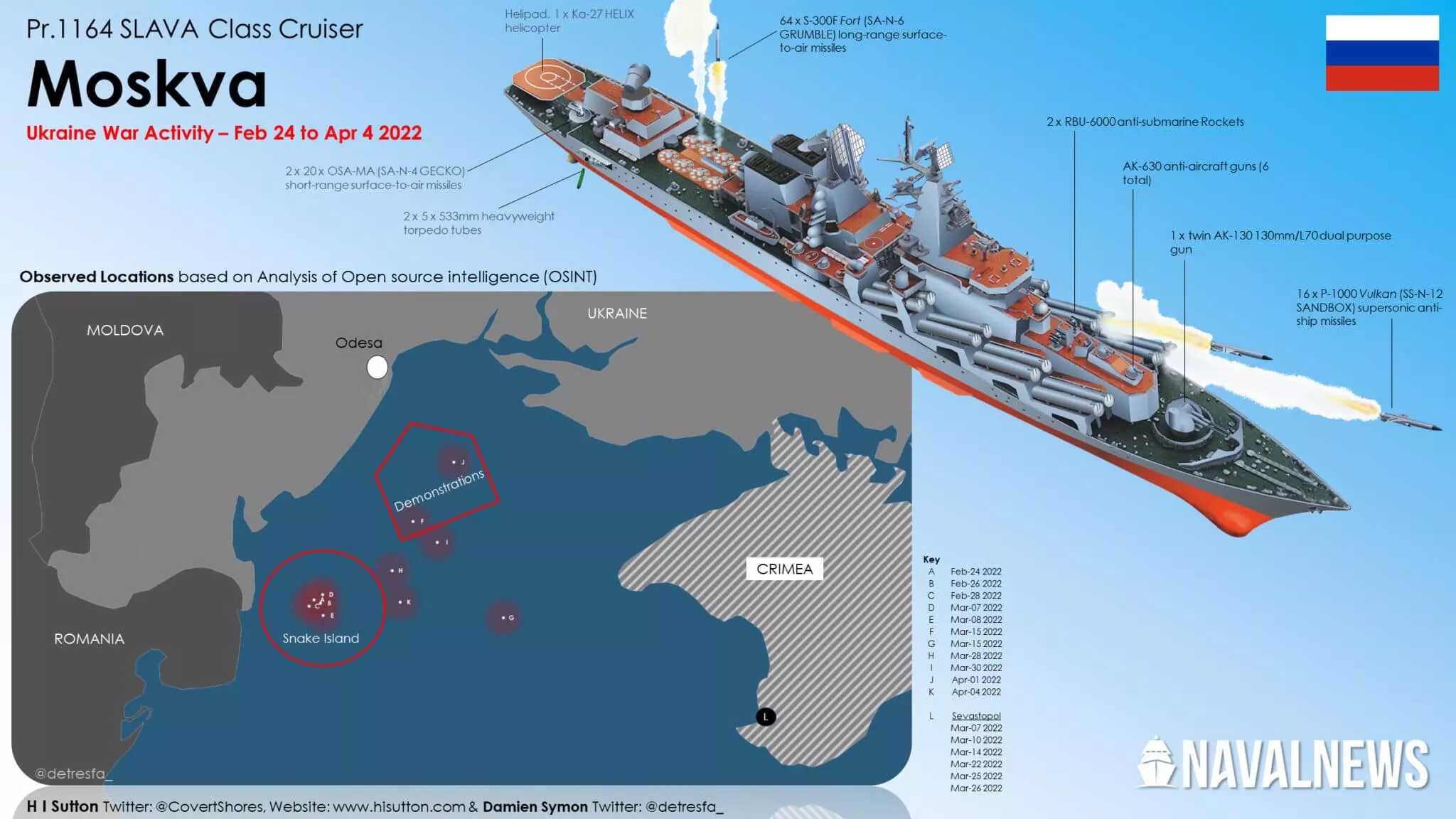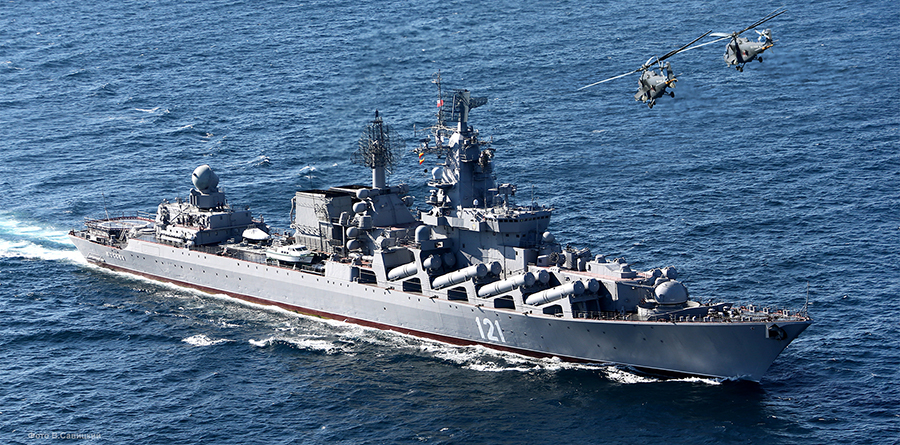Nuclear capable “aircraft carrier killer”
The cruiser Moskva was laid down and built as Slava (“Glory”) at a shipyard in the Ukrainian city of Mykolaiv in the late 1970th. Nicknamed “aircraft carrier killer,” this class of ships was designed by the Soviet Union to counter US aircraft carrier groups and provide air defense for Soviet ships on the open seas. The Western name for this class of ships has been Slava after the first ship of this class built by the USSR.
In 2000, Russia recommissioned Slava as Moskva (“Moscow”). In 2008, the ship was deployed near the Georgian coast amid the Russo-Georgian war. The Moskva cruiser took part in the Russian invasion of Crimea in March 2014, blocking the Ukrainian Navy vessels. In 2015-2016, the missile cruiser provided air defense for Russian troops in Syria.
At the beginning of the Russian invasion of Ukraine on 24 February, the Moskva was part of the navy group that attacked Ukraine’s Zmiinyi (a.k.a. Serpent or Snake) Island, lying about 35 kilometers south off the coast of Odesa Oblast. The audio of Ukrainian border guard Roman Hrybov from the Serpent Island responding “Russian warship, go f*ck yourself” to the Moskva’s demand to surrender became one of the symbols of the Ukrainian resistance to the Russian aggression, and became viral on the Internet worldwide.

Defense Express interviewed experts, including ship designers and naval officers, and those unanimously and independently gave the following answer: there is a real possibility that the flagship Moskva could have had nuclear munitions.
In the short term, there is no threat from the possible presence of nuclear weapons in the sunk Moskva, Defense Express says.
Russo-Ukrainian War, day 30: Ukraine sank Russian landing ship
Moskva’s last days
In Russia’s 2022 full-scale invasion of Ukraine, the cruiser Moskva led Russia’s naval assault on Ukraine and was central in the blockade of the Black Sea.

Amid the invasion, the Russian flagship Moskva used to operate off the coast of the Ukrainian port Odesa in the Black Sea. As of 7 April, it stayed in Sevastopol, occupied Crimea.

On 10 April, the Black Sea Fleet’s flagship was spotted leaving the harbor of Sevastopol:
Russian Project 1164 Atlant class guided missile cruiser Moskva spotted near Sevastapol today pic.twitter.com/AOGcFm35ci
— OSINTtechnical (@Osinttechnical) April 10, 2022

On the same day Maxar Technologies made its last satellite image of the Russian cruiser before clouds hid the area from the satellites:

The demise of the cruiser Moskva
On the evening of 13 April, Ukrainian military-related sources reported that the Ukrainian Armed Forces inflicted damage on the Russian Slava-class cruiser Moskva in the Black sea, using domestic anti-ship missiles Neptun. Some sources stated that the ship sank.
Later that day, Head of Odesa Regional Administration Maksym Marchenko confirmed the strike on Moskva, saying that the Ukrainian missiles “caused very serious damage to the Russian ship.”
In the early hours of 14 April, the Russian defense ministry admitted that a detonation of the ammunition occurred on Moskva due to a fire. The ministry said that the cruiser remained buoyant with its main weapons not damaged, and towing was being attempted, according to TASS.
At the moment of the incident, the ship was about 75 miles from Odesa, according to Washington Post, or 69 miles away, according to AP. Both media referred to an anonymous senior US defense official.
“All of the northern Black Sea ships have now moved out, away from the northern areas where they were operating in,” according to Pentagon, which likely means an attempt to get out of the range of the Ukrainian missiles.
Russian Telegram channels claimed that a Ukrainian Bayraktar TB2 drone distracted the attention of the ship’s air defenses from its starboard (right side) while the missiles hit the opposite port (left) board of the cruiser.
An Odesa resident reported on Twitter at 01:45 EEST (UTC+3):
“An intense glow (is visible from) Odesa in the direction of the Khadzhibey Estuary, without sound.”
This report may be related to the moment of the ammunition detonation on the Moskva cruiser or the subsequent fire.
At 2:57, one of the open-source intelligence (OSINT) Twitter accounts wrote that Moskva’s all radio signals disappeared:
https://twitter.com/OSINT88/status/1514392291120664585
About noon, Ukraine’s Operational Command South confirmed the attack on Moskva:
“In the Black Sea operational zone of anti-ship missiles Neptun, the hit cruiser Moskva – Russia’s Black Sea Fleet’s flagship – sustained significant damage, a fire erupted. Other units of the navy group tried to provide help, but a storm and a powerful explosion of ammunition overturned the cruiser and it started sinking.”
John Kirby, the Pentagon press secretary, told CNN that there was at least one explosion on the Moskva cruiser but said that the US couldn’t say if it was a missile that hit the vessel.
“We assess that the ship is able to make its own way, and it is doing that; it’s heading more towards, now, we think the east. We think it’s probably going to be putting in at Sevastapol for repairs,” Mr. Kirby added.
Only by the end of the day on 14 April, Russia confirmed the loss of its flagship:
“During the towing of the Moskva cruiser to the port of destination, the ship lost its stability due to damage to the hull received during the fire from the detonation of ammunition. In the conditions of stormy seas, the ship sank,” Russia’s Defense Ministry reported.
Russian navy’s missile capabilities after the loss of Moskva
Ukrainian expert Andrii Klimenko of the Black Sea News noted,
“After the missile cruiser Moskva bearing 16 cruise missiles was disabled, the total volley of cruise missiles of the Black Sea Fleet ships currently in the Black Sea decreased from 72 to 56.”
However, Moskva didn’t have any Kalibr missiles but rather had the cruise missiles Vulkan designed to attack large surface targets.
Amid its invasion of Ukraine, Russia widely uses its Kalibr ballistic missiles to attack the military and civilian targets in Ukraine. In the Black Sea, the Russian navy now has four ships equipped with eight Kalibr missiles each. Those are two frigates – Admiral Essen and Admiral Makarov, and two corvettes – Ingushetia and Grayvoron. Additionally, four Russian submarines – Rostov-on-Don, Stary Oskol, Veliky Novgorod, Kolpino – have four Kalibrs each.
Further reading:
- Russo-Ukrainian war, day 40: Russian frigate hit by rocket
- Ukraine sank Russian landing ship in occupied Azov Sea port
- What weapons for Ukraine would help it win the war against Russia
- China may help Russia’s navy in Azov, Black and Caspian seas by deepening and widening Volga-Don Canal
- Russia rapidly moving landing ships, submarines of Baltic, Northern & Pacific fleets to Black Sea (early February 2022)
- How Ukraine can prevent an imminent Russian blockade of the Black & Azov Seas (early February 2022)








